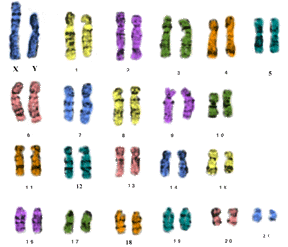
Contents
Genetics Index
The Basics
Chromosomes and
Genes
Dominant and Recessive,
Genotype and
Phenotype
Homozygous and
Heterozygous
Sex Chromosomes and
Sex Linkage
X-Inactivation
Mutation
Mutation Basics
Mutation in Syrians
Table of Mutations
Inheritance
Gametes
Punnett Square
Monohybrid Cross
Dihybrid Cross
Trihybrid Cross
Linkage
Sex Linkage
A Common
Misconception
Probability
The Nuts and Bolts
Examples
Principles of Breeding
Breeding Techniques
Dominant Traits
Recessive Traits
Epistasis
Lethality
Inadvisable Crosses
Lineal Purity v.
Heterogeneiry
Tortoiseshells and
Tricolors
Genotyping
Agouti v. Self
Basic Colors
The Golden Genotype
Combination Colors
Coat Types
Patterns
Eye Color
Ear Color
The Preliminary Genotype
Expanding the Genotype
• Parents
• Siblings
• Offspring
River Road Hamstery
(limited version)
Contact
|
Syrian Hamster Genetics: The Basics
A given pair of genes (on sister chromosomes) may be identical or may be subtly different. For example, in a gene pair governing eye color, one gene form (called an allele) may code for blue while the other codes for brown. There could be additional forms of the eye color gene, but an individual can only have two of them at most - one on each homolog. The exact location of a gene in a set of chromosomes is called its locus (pl. loci) and is the same for all members of a species.
Each gene that has been identified is given a letter symbol. If an allele affects the appearance of the animal when it is present in only one copy, that allele is said to be dominant and the symbol is capitalized. A recessive allele has to be present in two copies to show an effect, and the symbol is written in lower case. To use the eye color example, the allele for brown eyes happens to be dominant and is represented by B. The allele for blue eyes is recessive, and is represented by b. Since a person must have two alleles for each trait, the possible genotypes (listings of genetic code) are BB, Bb and bb. Both BB and Bb individuals would have brown eyes, since brown is dominant and overrides the expression of b in Bb. Only in the bb genotype would the eyes be blue, since there is no dominant allele to prevail. Phenotype is the visible property produced by the genotype, or to put it another way, phenotype is what the animal looks like. So BB and Bb individuals have different genotypes but the exact same phenotype. (As a cautionary note, some alleles, although they are written in upper case, are incompletely dominant so that the individual with two dominant alleles would differ in appearance from the individual with one dominant and one recessive.) If the two alleles of the pair are identical in form, such as in BB or bb, the individual is said to be homozygous for that trait. If the forms are different, as in Bb, the individual is heterozygous. Homo- is a prefix meaning alike; hetero- means different.
One special pair of chromosomes in higher animals is not matched one-for-one in the traits they code for. In fact, they don't even look alike under a microscope. One looks like an X and the other like a Y, one arm being highly abbreviated. Their shapes lend them their names, X and Y. (All of the other chromosome pairs, called autosomes, are numbered, not named.) An animal or person with two X chromosomes is female; one with an X and a Y is male. For this reason the X and Y are called sex chromosomes. It is important to note that the genes on the sex chromosomes are not necessarily related to sexual characteristics but can govern any trait. Since genes on the sex chromosomes are transmitted along with the information determining the the animal's sex, they are said to be sex-linked. There are a number of genes on the X chromosome that simply have no counterpart on the Y. For these genes, in a male, whatever allele is on the X will determine the phenotype all by itself. In a female an allele for a trait will exist on each X as on the other chromosomes, but they will not function the same way as autosomal genes. Early in development, one X in every cell is chosen to be active for the entire life of the animal. The other is shut down. This is termed X-inactivation or sometimes, rationalization. Each of these early cells, when it divides to form more tissue, passes along the propensity for the same X to remain active. In the end the female is a mosaic, composed of some areas where the single allele on one X is governing phenotype and other areas that are mandated by the allele on the second X. |

No part of this website may be reproduced in any form or by any means
without the prior written consent of the owner.
 Nearly all physical characteristics are coded for on huge molecules of DNA (chromosomes) which are found in the nucleii of most cells in the body. Chromosomes exist in
look-alike pairs, called homologous pairs. The characteristics coded for on a particular chromosome will be matched one-for-one on its sister chromosome. Each tiny section of DNA
comprises a gene, and each gene pair controls exactly one feature of the animal.
Nearly all physical characteristics are coded for on huge molecules of DNA (chromosomes) which are found in the nucleii of most cells in the body. Chromosomes exist in
look-alike pairs, called homologous pairs. The characteristics coded for on a particular chromosome will be matched one-for-one on its sister chromosome. Each tiny section of DNA
comprises a gene, and each gene pair controls exactly one feature of the animal.